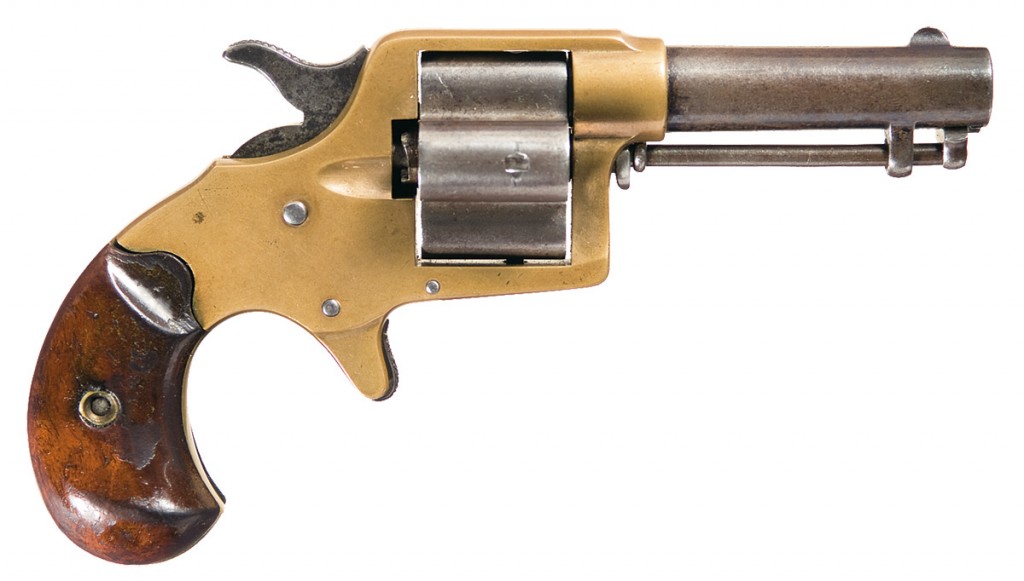 Also known as the Colt Cloverleaf, the Colt House Pistol was a small 4-shot single-action revolver chambered for .41 short/long rimfire. The image above is a typical example.
Also known as the Colt Cloverleaf, the Colt House Pistol was a small 4-shot single-action revolver chambered for .41 short/long rimfire. The image above is a typical example.
Available with 1.5″ and 3″ barrels, this gun was designed to fill the same role as a derringer: small personal protection, but with greater ammunition capacity. The frame looks like bronze; there were nickel-plated versions available. The blued versions, and the models with the short barrel, carry a high premium.
The 4-shot cylinder had a unique shape which led to the “Cloverleaf” nickname.
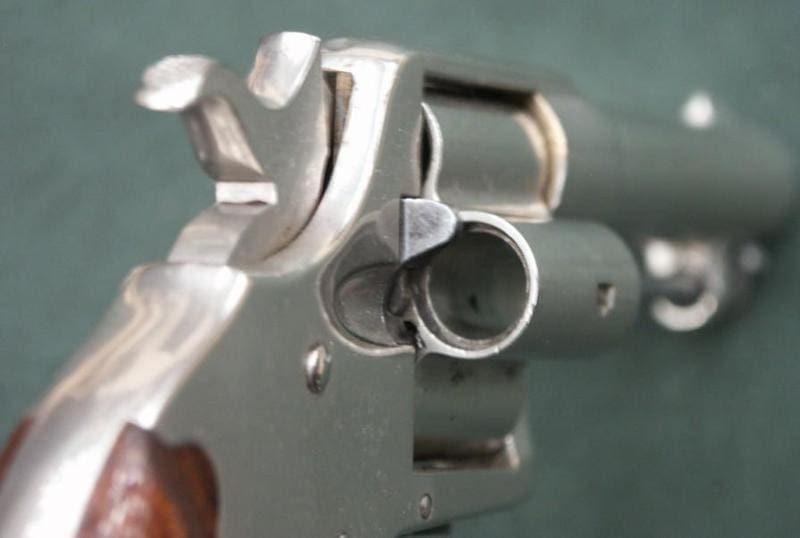
Chambered in the same .41 short rimfire cartridge that Remington derringers used, it was not a very powerful round.
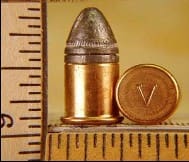 The 130gr projectile only had 13gr of black powder to make it go. Translation: approximately 425 fps velocity and 52ft/lb of energy. From the Wikipedia entry: “Cartridges of the World states that when fired at a hard object, such as a tree, from a distance of 15 yards (14 m) or more, the bullet often bounces off. Reportedly, when shot at a target more than 20 yards away, the shooter hears two distinct reports: first the gun being fired; and second, the lead bullet striking the target.” There was also a .41 rimfire long cartridge, which was only marginally more powerful.
The 130gr projectile only had 13gr of black powder to make it go. Translation: approximately 425 fps velocity and 52ft/lb of energy. From the Wikipedia entry: “Cartridges of the World states that when fired at a hard object, such as a tree, from a distance of 15 yards (14 m) or more, the bullet often bounces off. Reportedly, when shot at a target more than 20 yards away, the shooter hears two distinct reports: first the gun being fired; and second, the lead bullet striking the target.” There was also a .41 rimfire long cartridge, which was only marginally more powerful.
Colt made about 7500 of the standard Cloverleaf between 1871 and 1876. But they also made another version, with a 5-shot unfluted cylinder. This is the version I took pictures of:
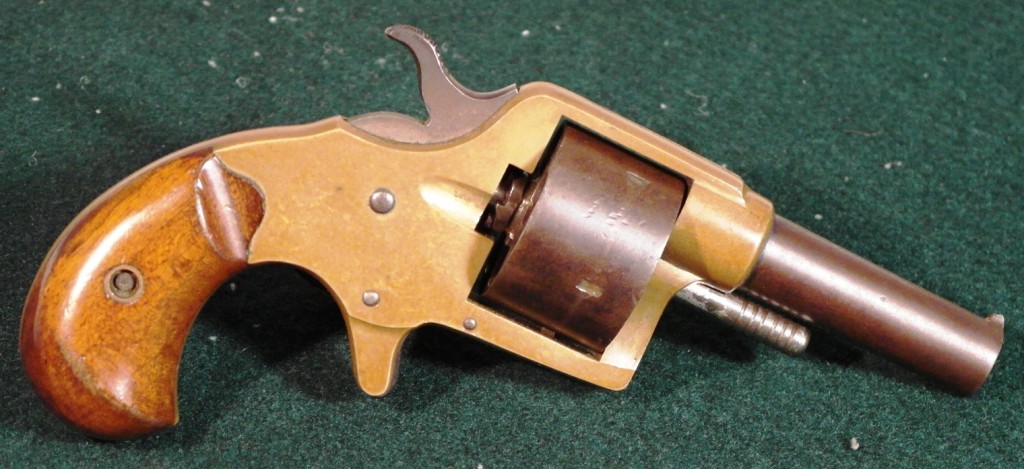
This version was only made with a 2-5/8″ barrel, and only 2,500 were made. Yet the more common 4-shot version is more valuable.
There is a ding in the front sight of this 5-shot example, and it is bent over to the right. I don’t know if that is accidental damage, or an intentional modification to adjust the point of aim. The rear sight is a channel cut into the topstrap.
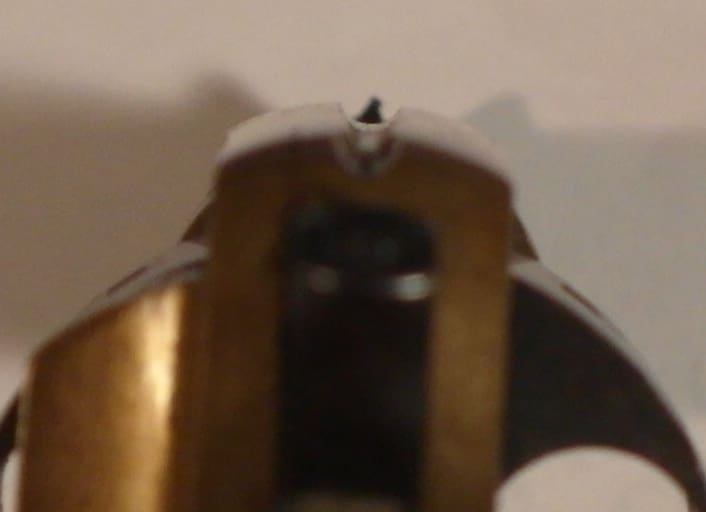
As a single-action revolver with a spur trigger (and no trigger guard), the action is pretty stiff.
 I recall that a company made some .41 rimfire ammo a few years back. It was expensive when it was sold new, and even more expensive now that there are a limited # of rounds left. I don’t have any, so I cannot provide any shooting impressions. I will keep my eye open at gun shows, maybe I can find a few.
I recall that a company made some .41 rimfire ammo a few years back. It was expensive when it was sold new, and even more expensive now that there are a limited # of rounds left. I don’t have any, so I cannot provide any shooting impressions. I will keep my eye open at gun shows, maybe I can find a few.
It’s a neat little piece, and a part of Colt’s history here in Connecticut.




Try here http://americancustom.tripod.com/ they made ammo for a friends 7mm Nambu. They may be a bit pricey but an email for a quote only costs you time.
Thanks for that.
Certainly obsolete since perhaps the 1870’s. Yet, this still beats throwing
rocks, swinging a stick, brandishing a pocket knife, pair of scissors, or
whatever. Fortunately the venerable .38 Special remains with us and
despite it’s origin in 1899, it is still very much alive. My idea of a classic
house handgun is exactly that: a .32 or .38 caliber revolver (double action
with 5 or 6 shot swing out cylinder).
Does anyone out there know how to ascertain an approximate production date of the .41 cal. rim fire cartridge from information on the box? The box is really old, I would guess turn of the last century, and as I recall, the company is Union Metallic Cartridge. Any idea of the value of the box and/or cartridges? Thanks.
My aunt has several old pistols including a Colt 4 shot House Pistol, with a Serial Number of 6279. The gun does not look like it has been refinished and is in good (my valuation not NRA) condition. She has asked me to dispose of the guns and I do not know the value of antique guns. How can I determine the value to a collector (not resale value) of these guns? Any help you can give will be appreciated.
The value is important to the 91 year old because it will help pay her assisted care expenses. jel
My aunt has several old pistols including a Colt 4 shot House Pistol, with a Serial Number of 6279. The gun does not look like it has been refinished and is in good (my valuation not NRA) condition. She has asked me to dispose of the guns and I do not know the value of antique guns. How can I determine the value to a collector (not resale value) of these guns? Any help you can give will be appreciated.
The value is important to the 91 year old because it will help pay her assisted care expenses. j
http://hlebooks.com/32rfkit/prices.htm
You can get brass, bullets, and reloading tools for RELOADABLE .32, .38. and .41 rimfire cartridges (and pinfire cartridges, as well) there.
Comments are closed.